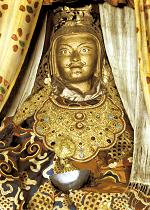Padmasambhava: Difference between revisions
No edit summary |
No edit summary |
||
| Line 1: | Line 1: | ||
[[Image:Guru ngadrama.JPG|frame|The famous 'Looks Like Me' statue of Guru Padmasambhava]] | |||
'''Padmasambhava''' [Skt.], or Padmakara [Skt.] - ''Pemajungné'' [Tib.], the ‘Lotus-Born’, which refers to his birth from a lotus in the land of [[Oddiyana]]. Also known as '''Guru Rinpoche''', the ‘Precious Master’, he is the founder of Tibetan Buddhism and the [[Buddha]] of our time. Whereas Buddha is known primarly for having taught the teachings of the sutra vehicle, Padmasambhava came into this world, and to Tibet in particular, in order to teach the tantras. While [[Buddha Shakyamuni]] exemplifies the buddha principle, the most important element in the [[sutrayana]] path, Padmasambhava personifies the guru principle, the heart of [[Vajrayana]] Buddhism, and he is therefore known as ''sangyé nyipa'' [Tib.], the ‘second Buddha’. | '''Padmasambhava''' [Skt.], or Padmakara [Skt.] - ''Pemajungné'' [Tib.], the ‘Lotus-Born’, which refers to his birth from a lotus in the land of [[Oddiyana]]. Also known as '''Guru Rinpoche''', the ‘Precious Master’, he is the founder of Tibetan Buddhism and the [[Buddha]] of our time. Whereas Buddha is known primarly for having taught the teachings of the sutra vehicle, Padmasambhava came into this world, and to Tibet in particular, in order to teach the tantras. While [[Buddha Shakyamuni]] exemplifies the buddha principle, the most important element in the [[sutrayana]] path, Padmasambhava personifies the guru principle, the heart of [[Vajrayana]] Buddhism, and he is therefore known as ''sangyé nyipa'' [Tib.], the ‘second Buddha’. | ||
Revision as of 07:35, 19 May 2007

Padmasambhava [Skt.], or Padmakara [Skt.] - Pemajungné [Tib.], the ‘Lotus-Born’, which refers to his birth from a lotus in the land of Oddiyana. Also known as Guru Rinpoche, the ‘Precious Master’, he is the founder of Tibetan Buddhism and the Buddha of our time. Whereas Buddha is known primarly for having taught the teachings of the sutra vehicle, Padmasambhava came into this world, and to Tibet in particular, in order to teach the tantras. While Buddha Shakyamuni exemplifies the buddha principle, the most important element in the sutrayana path, Padmasambhava personifies the guru principle, the heart of Vajrayana Buddhism, and he is therefore known as sangyé nyipa [Tib.], the ‘second Buddha’.
See the ‘The Life of Guru Padmasambhava’ in A Great Treasure of Blessings.
- See also Attributes of Guru Rinpoche.